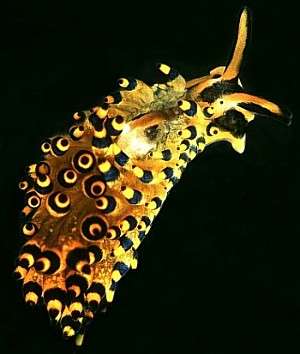

Stiliger ornatus
Ehrenberg, 1828
Order: SACOGLOSSA
Superfamily: LIMAPONTIOIDEA
Family: Limapontiidae
DISTRIBUTION
Tropical Indo-West Pacific
PHOTO
Reef crest at low tide on the green alga, Codium spongiosum, November 1997., 10mm long alive. Heron Island, Great Barrier Reef, Queensland, Australia. PHOTOS: Julie Marshall.
Stiliger ornatus which was illustrated and named by Ehrenberg in 1828 (with the description of the species appearing in 1831) from the Red Sea. It has also been recorded from Mozambique (Macnae & Kalk 1960) and from Japan (Baba & Hamatani 1970) although the Japanese specimens had slight differences from the original description. All the specimens found at Heron Island closely resemble Ehrenberg's original description.
Stiliger ornatus is the type species of the genus Stiliger.
Refererences:
• Baba.K. & Hamatani, I. (1970) Occurrences of specimens presumably identifiable with Stiliger ornatus Ehrenberg, 1831, at Seto, Kii, Middle Japan. Publications of the Seto Marine Laboratory, 18(3): 199-206.
• Ehrenberg, C.G. (1828 pls, 1831 text) Symbolae physicae seu icones et descriptiones animalium evertebratorum sepositis insectis quae ex itinere per Africam Borealem et Asiam Occidentalem - novae aut illustratae redierunt. Decas 1 Mollusca.
Marshall, J., 1999 (July 9) Stiliger ornatus Ehrenberg, 1828. [In] Sea Slug Forum. Australian Museum, Sydney. Available from http://www.seaslugforum.net/find/stilorna
Related messages
Re: Stiliger ornatus
November 26, 2003
From: Cynthia Trowbridge
Dear Bill and colleagues,
I have recently returned from working in Okinawa with Yoshi and Yayoi Hirano and their graduate students. On this visit (Nov 2003) to the west coast of the main island of Okinawa, we were able to find 2 specimens of Stiliger ornatus -- which was an exciting record for us.
Stiliger ornatus, was initially found in Japan at Seto, Kii in June and August (Baba & Hamatani, 1970) and then reported for Futo, Izu Peninsula (Suzuki, 2000). In Seto, the algal host was Codium spongiosum (= pugniforme); in Australia, the host species was the same.
In Okinawa, we found 2 Stiliger ornatus on the green alga Codium intricatum. This alga is common in low intertidal to shallow subtidal (<1 m) areas at many sites on the west coast of Okinawa. We confirmed that the sacoglossans actually fed on this alga in lab experiments.
Sacoglossans have been reported to feed on at least 9 of the 17 species of Codium on Japanese shores. The Hiranos and I are finishing several manuscripts on the assemblage of sacoglossans (Placida, Elysia, Stiliger spp.) that feed on Codium in Japan. We have been studying Sagami Bay populations for 4 years but this Okinawa record is our first sight of Stiliger ornatus. This species is GORGEOUS!
• Baba.K. & Hamatani, I. (1970) Occurrences of specimens presumably identifiable with Stiliger ornatus Ehrenberg, 1831, at Seto, Kii, Middle Japan. Publications of the Seto Marine Laboratory, 18(3): 199-206.
• Suzuki, K. 2000. Opisthobranchs of Izu Peninsula. TBS – Britannica Co., Ltd, Japan.
Cordially,
Cynthia
trowbric@onid.orst.edu
Trowbridge, C., 2003 (Nov 26) Re: Stiliger ornatus. [Message in] Sea Slug Forum. Australian Museum, Sydney. Available from http://www.seaslugforum.net/find/11426Thanks Cynthia,
I look forward to seeing the published manuscripts
Best wishes
Bill Rudman
The larvae of Stiliger ornatus
August 7, 2003
From: Tzan-Chain Lee
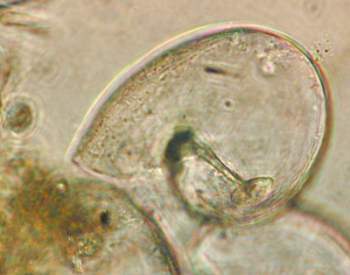
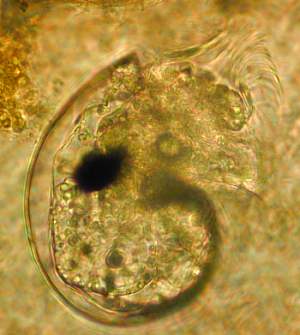
Dear Bill,
I am a student of National Tsing Hua University of Taiwan. I am studying the physiology of Stiliger ornatus. Recently, I have take some pictures of its larvae. But sometimes I only found its shell. May I ask a question "When does the larva leave its shell"?
Thanks a lot for reading my question?
Best Wishes
Tzan-Chain Lee
crane173@yahoo.com.tw
Lee, T-C., 2003 (Aug 7) The larvae of Stiliger ornatus. [Message in] Sea Slug Forum. Australian Museum, Sydney. Available from http://www.seaslugforum.net/find/10672Dear Tzan-Chain,
I don't know of any study on the development of Stiliger ornatus but from the well-developed velum, with large cilia, seen in your lower photo, I would suspect that in this species the larva spends some time as a free-swimming planktonic veliger. Normally it would only lose its shell after it has settled down on to the substrate and begun to metamoprhose into a crawling slug.
I guess you are keeping egg masses in the laboratory to study? Unfortunately, I think in your case that the empty shells are a sign that the larvae have died and rotted away.
Best wishes,
Bill Rudman
Trailing behaviour by Stiliger ornatus
April 5, 2001
From: Julie Marshall

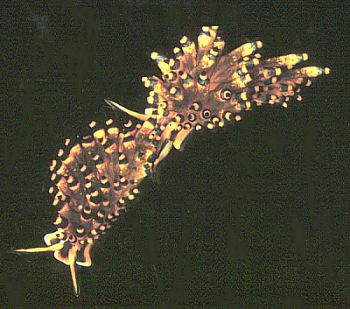
Dear Bill,
Attached are two pictures of Stiliger ornatus trailing each other. They were found on Codium spongiosum under a dead coral slab at the reef crest on Heron Island on 7 March 2001. Their size was 6 and 7 mm. When I brought them into the lab they began this trailing behaviour. If parted they quickly circled round till they found each other again. In all cases the darker, slightly smaller animal led the other paler animal.
Best wishes
Julie Marshall
j.marshall@latrobe.edu.au
Marshall, J., 2001 (Apr 5) Trailing behaviour by Stiliger ornatus. [Message in] Sea Slug Forum. Australian Museum, Sydney. Available from http://www.seaslugforum.net/find/4116Thanks Julie,
We still have almost everything to learn about behaviour in these animals. If you ever a get a chance to take a photo of species with their food, or a photo just of the food, it would be very useful as a record and as an educational guide to us all.
Best wishes,
Bill Rudman
Stiliger ornata, Placida dendritica? from Taiwan
March 11, 2000
From: Jui-Sheng Chang
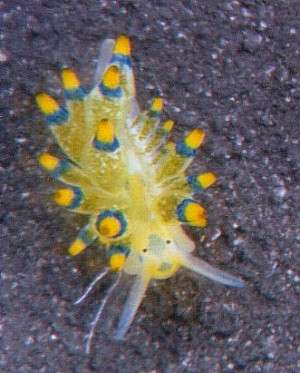

Dear Dr. Rudman:
I am Jui-Sheng Chang, a student in National Taiwan University. I am studying the Codium blooming on coral reef in southern Taiwan. I have found two kinds of sea slugs which are living with Codium edule. But I do not know what the species names are.
One of both them looks like Stiliger ornata, but the rings under the ceras top are blue. Is there any differences between them? The length of both unknown species is only about 0.5 cm. They can feed with Codium edule and lay eggs on the Codium branches.
Thanks you so much for looking my questions. Best Wishes
Your Sincerely
Jui-Sheng Chang
d5241003@ms.cc.ntu.edu.tw
Chang, J-S., 2000 (Mar 11) Stiliger ornata, Placida dendritica? from Taiwan. [Message in] Sea Slug Forum. Australian Museum, Sydney. Available from http://www.seaslugforum.net/find/2067Dear Jui-Sheng Chang,
The upper photo is indeed Siliger ornata, the photos in the Forum are of a very dark individual.
The lower photo is of a species I am tentatively calling Placida dendritica but as you will see if you read the messages on that page, the general feeling is that there are a complex of similar looking species worldwide which will need sorting out. The ramifying green pattern you can see are ducts of the digestive gland containing green chloroplasts from Codium which it probably keeps alive in its body. See the page on Solar powered slugs for information on how these animals utilise the chloroplasts.
Any other photos of their egg masses would be very welcome. Good luck with your research, and if you have anymore questions please let us know.
Best wishes,
Bill Rudman.
Re: Stiliger ornatus at Heron Island
July 15, 1999
From: Julie Marshall
Dear Bill,
I was very interested in your field drawings of Janolus mirabilis and the other information about your specimen from Tanzania. I should also like to congratulate you on the web site and in the way you answer all questions and the extra information and images you provide. It is very useful in building up information about particular species.
I always find Stiliger ornatus in the area of Heron Reef close to the A/B Zone marker east of Blue Pools where there is a concentration of Codium spongiosum. All my recent trips to Heron Island have been in summer but I am going there briefly at the end of July so it will be interesting to see if I can.
Julie Marshall.
j.marshall@bl1.lib.latrobe.edu.au
Marshall, J., 1999 (Jul 15) Re: Stiliger ornatus at Heron Island. [Message in] Sea Slug Forum. Australian Museum, Sydney. Available from http://www.seaslugforum.net/find/1065Stiliger ornatus from Heron Island
July 11, 1999
From: Julie Marshall


Hi Bill,
Attached are dorsal and ventral photographs of Stiliger ornatus which was illustrated and named by Ehrenberg in 1828 (with the description of the species appearing in 1831) from the Red Sea. It has also been recorded from Mozambique (Macnae & Kalk 1960) and from Japan (Baba & Hamatani 1970) although the Japanese specimens had slight differences from the original description. The specimens found at Heron Island closely resemble Ehrenberg's original description. I am sure you will get reports of other records once these pictures appear on your page! The pictured animal was 10 mm and was found at the reef crest at low tide on the green alga, Codium spongiosum in November 1997. Since finding this animal I have found three others in December 1997 and December 1998 - all on, or beside the same species of Codium. I have also found Placida dendritica and Elysia maoria on Codium spongiosum at Heron Island.
Best wishes
Julie Marshall
j.marshall@latrobe.edu.au
Marshall, J., 1999 (Jul 11) Stiliger ornatus from Heron Island. [Message in] Sea Slug Forum. Australian Museum, Sydney. Available from http://www.seaslugforum.net/find/1031Dear Julie,
Thanks for another interesting contribution. Ever since seeing Baba & Hamatani's paper I have hope one day to see this animal alive. Your photos are the next best thing.
Best wishes,
Bill Rudman.
